Kalanchoe blossfeldiana often goes by the shortened name of Kalanchoe or by its more common names of Widow's-thrill and Flaming Katy, derived from its colorful and vibrant blooms.
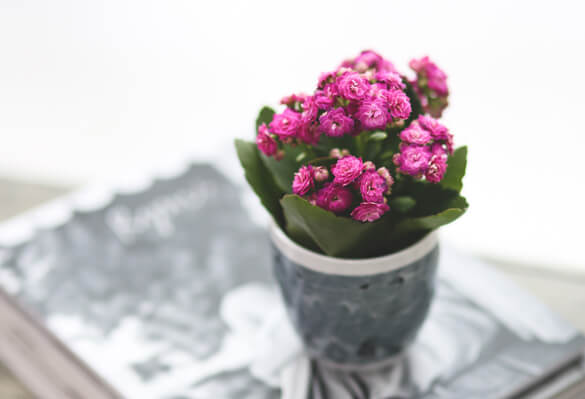
Pink flowering Kalanchoe (also known as a Widow's-thrill or Flaming Katy)
As a present for a birthday, anniversary or to bring life to a dull table are all reasons people will buy this readily available and inexpensive houseplant. But like the Gerbera and Pot Mum its time in the home tends to be fleeting.
On one hand, you have a houseplant that although very compact is often smothered in small and numerous flowers with vivid colours lasting for many weeks (sometimes even months if conditions are cool and you deadhead the spent blooms). This without question is its main attraction, throwing colour and flaming beauty at you.
However, on the other hand, you have the Flaming Katy's brittle green succulent like leaves underneath, supporting and producing these amazing flowers.
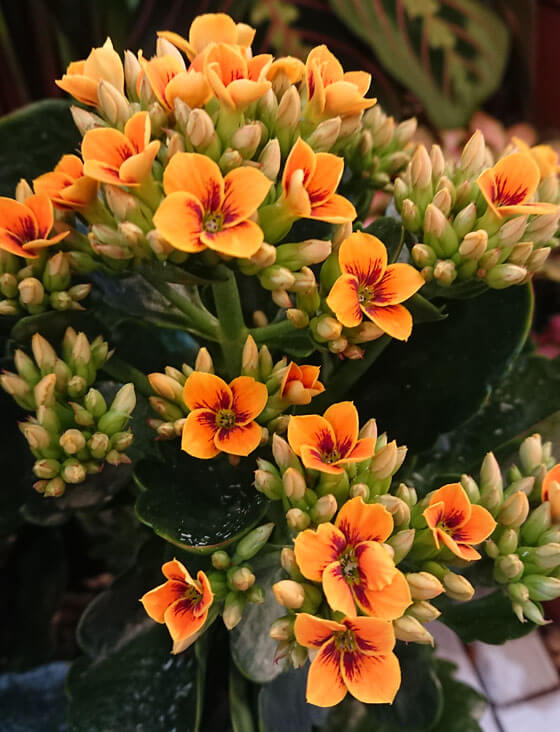
Kalanchoe "Tiger" Orange
The problem with this is that the leaves are sort of boring or to some, even ugly in comparison. And although the plants will easily reflower again and again in the future, while waiting for their reappearance they take up valuable shelf or desk space that might be better suited for more attractive foliage plants. Hence the reason for their disposable nature as a houseplant.
This drawback is such, that it's not uncommon for people to throw the Flaming Katy away after the flame has died out. Some sellers will try to avoid this by grouping them in pots with other types of houseplants to prolong the display and keep some visual interest for a longer period.
The sometimes limited lifespan is a shame because looking beyond the surface it's a very easy and versatile houseplant to have around and as mentioned above, the flowers do often return again with minimal care, providing light levels are bright enough.
How do you pronounce Kalanchoe correctly? Say: KA-luhn-CHO
Kalanchoe is a vast species and several will be grown as houseplants, but as this article focuses on the Widow's-thrill / Flaming Katy this is the only variety we're looking at.
You will most likely see the pot labeled as "Kalanchoe blossfeldiana". There are few cultivars available, and all the ones I've personally seen have totally solid, succulent like deep green leaves. i.e. there are no variegated types around.
The double-headed flowers were the most popular for a long time, but a newer variety is starting to become very sought after and that's Kalanchoe blossfeldiana "Tiger".
We're posted several photos of this type within the article itself. As you can see the flowers are singles with four neat overlapping petals, but they often have an amazing bold contrast with colours. It's a striking sight! Seek these out if you want something a bit different.
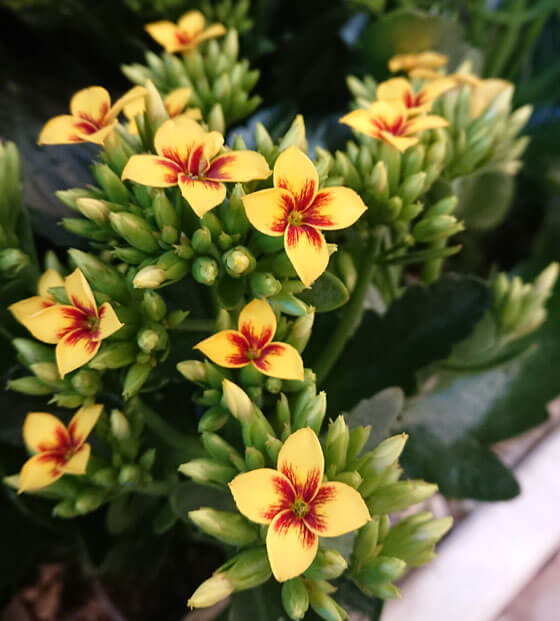
Kalanchoe "Tiger" Yellow
Kalanchoe is poisonous to pets (and people) if ingested, but it's typically impervious to pests and it also features in the top 50 houseplants to clean the air, so if desired and safe to do so it's definitely worth keeping around.
Now time for some photos to make you fall in love with it, before getting on to the easy care instructions.

Hi, I'm Tom!
If you're like me and enjoy the challenge of growing houseplants and getting them to thrive, then Ourhouseplants can help. This website shares my knowledge and years of growing plants and provides (hopefully) helpful advice on properly caring for your indoor plant friends.
For a month or so Kalanchoe will cope with dark areas in your home or office. This is perfect if you've chosen such a spot to show off a newly brought plant that is in full bloom.
In the longer-term low light conditions will cause your plant to grow leggy and spindly, which ruins the compact nature of this houseplant. They need bright light, and ideally an hour or so of sun a day. Failure to provide this will eventually finish the plant off and the flowers won't be back. Aim for good light locations and the plant will be happy.
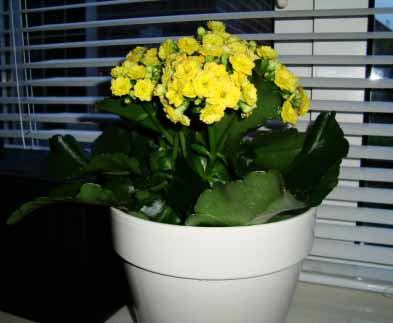
A Flaming Katy houseplant sitting in a window
The occasional or forgetful indoor gardener will love the Flaming Katy as it will take erratic and sparse watering due to the succulent fleshy leaves being able to store water for several weeks at a stretch.
An attentive owner wanting a prosperous plant will water heavily once the soil has dried out quite a lot and then will wait until it's dry again. In the height of Summer, this could be once a week. In cold months of the year, only a small amount of water is needed every couple of weeks at the most.
As with many succulent like houseplants the humidity level isn't something you need to worry about. Although if humidity is quite high in your home, good ventilation will help prevent Basal Stem Rot and Botrytis.
Plants in bloom don't need any feeding. A few weeks after all the flowers have faded a standard houseplant feed is all you need.
Alternatively, you can use a feed that is designed for flowering plants, this will have a higher level of potash / potassium designed to encourage more blooms next time it flowers. No need to go mad here though. Feeding once every couple of months will be more than plenty.
Between 10°C (50°F) up to 22°C (72°F) is the ideal temperature range for the Kalanchoe, although it should still be okay if it slips outside of these ranges on occasion. Just make sure you avoid frost and if it's very cold, you must follow the watering instructions above by reducing the amount of water you give your plant.
Reduce the amount of water you give when light or temperature levels are low
Should you choose to keep the plant after flowering has finished, then when it comes to repotting you should use a soil mix that is either very free draining, or add some grit or sand to the medium you are using.
Look to repot every couple of years but when you do, be careful as the leaves are quite brittle and will snap easily with rough handling.
This is quite easy to do by Leaf Cuttings should you want to propagate new plants that are true to their parents.
Growth is generally slow no matter the conditions your plant finds itself in. However because the plant is rather small anyway, a little growth over an entire season can still make it look quite different. The maximum height and spread are usually reached between 3 and 5 years.
Few indoor Kalanchoe blossfeldiana's will ever be taller or wider than 30cm / 12in, which gives a pretty dainty specimen. A compact plant gives the ideal look. If your plants become spindly and leggy then you haven't been providing enough light.
This houseplant certainly has flowers to shout about. Reds, pinks, oranges, yellows, purples and whites are all common, coming in either singles with four petals or doubles with eight or more petals.
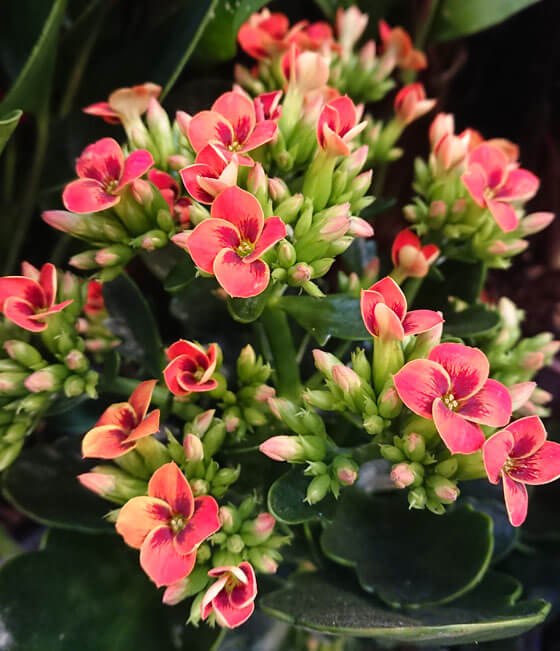
Kalanchoe "Tiger" Pink showing the flowers with four overlapping petals
It's usual to have 50 or more blooms at a time so all you really see from a casual glance is one big cloud of colour but if you get in close the detail on each flower is both phenomenal and stunning. Some tips to get your Kalanchoe flowering again.
Kalanchoe's are toxic to people, cats or dogs if consumed in large quantities. The symptoms are usually only mild even if a large amount of the plant is eaten, but will often include vomiting and diarrhea.
How do you prolong the flowers?
To prolong the flowering period of your Kalanchoe choose a cooler space away from strong heat and bright sunlight. As the blooms start to fade, deadhead by removing them carefully from the flowering cluster.
How do you get the Flaming Katy flowering again?
Re flowering can be brought on by playing around with light levels to fool the plant. But in our experience just keeping them in a bright semi-sunny position following the care instructions above is enough to get them blooming again in the future.
The only "trick" therefore is to let them rest for a month after the original flush of flowers has finished. During which point don't give any feed at all and only just a little water during this period. After a mont,h resume standard care and new buds should eventually appear.
Average to Bright Light Low light won't work here and intense summer sunlight will burn the leaves. Good light levels are needed for repeat flowering.
Average Watering Once every week or so in the Summer and perhaps once every two or three weeks in Winter. Let the soil dry out between watering.
Warm Temperatures Warm temperatures are preferred. Not lower than 10°C (50°F).
Average to low Feeding When looking at feeding plants, once every couple of months is enough. Feed designed for flowering plants is ideal, but a normal houseplant fertiliser will be fine too.
Not necessarily a "problem" but it's an indication you aren't providing enough light. If the light levels are low the plant will leave its compact nature behind and become leggy as it spreads itself out to maximize the light it does receive.
Dusty Leaves
Again not really a problem. The leaves easily attract dust, so put the plant under a shower or wash it briefly under a tap once or twice a year.
Disease
Along with pests, in general, the Flaming Katy holds its own well against diseases. The only ones you are likely to come across are caused by too much watering combined with high levels of humidity and poor ventilation as Crown and Stem Rot and Grey Mold are much more common in these conditions.
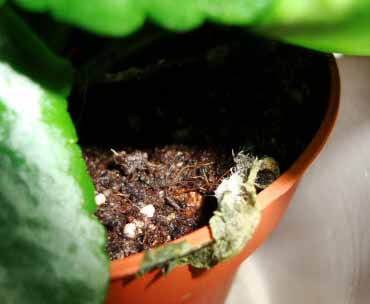
Grey Mold strikes a fallen Flaming Katy leaf
In the picture above Grey Mold (Botrytis) has taken hold on a fallen leaf, it should be removed as soon as possible to prevent the risk of it spreading to any healthy growth.
Leaf distortion / Leaf Curl
Normally this is a result of certain insecticides. Where possible you should use organic methods of pest control, however, if you use chemicals and leaf distortion ruins its appearance to such an extent, you will need to discard the plant.
Wilting leaves
Sometimes this can be what most people would expect when they see this - underwatering, but it can often be a sign of overwatering in this plant. It's easy to work out what's likely to have happened.
When you see the wilting leaves feel the soil:
When underwatered a good soaking will restore the leaves to their usual appearance within a few days. If overwatered, then it depends on how bad the wilt is. If only mild the plant should recover in time. If it's significant then it's likely the plant is too far gone to be saved and the roots have already started to rot. The only way to establish which, is by taking the plant out of its pot and having a look.
Yellow leaves
Kalanchoe plants will shed their leaves if you constantly don't water enough. They go yellow because the plant has "unalived" that particular leaf but is first taking out all of the "goodness" and transporting it to other areas.
This is ultimately a self preserving attempt, better to lose a few leaves and regrow them, rather than die totally. It's not good for the plant in the long term however so work on your watering skills moving forward.
I've not owned a solo Flaming Katy / Widow's-thrill for a few years now, but I did have a lovely double blooming one with yellow flowers for about four years. It stayed nice and compact for a long time and flowered a few times a year with minimal fuss.
This is an easy-going and undemanding houseplant. When it flowers it's like a beautiful bouquet that lasts several months. When the flowers are spent it hides away in whatever space or spot I found for it and it was easily pleased with a bit of water and some feed every now and again. So much so, that normally the flower buds would just appear out of the blue and start to open and catch me by surprise.
Eventually, most Flaming Katy's do start to get leggy even if good care is provided. After about four years, mine had a larger space footprint and the flowers were less numerous. I decided to move it outside for the Summer and it sort of blended into garden life...
Let's just say it blended in a little too well and it gracefully made it's exit when, I er , forgot it was in the garden and the Winter frosts arrived! (remember these plants do not like to be too cold!)
Anyway, this is a lovely houseplant for any collection and I'd certainly have one again, especially one of the newer "Tiger" varieties being sold now (see the early photos at the top of this article).
Credit for the Kalanchoe with pink flowers - Article / Gallery - by kaboompics
Credit for pink, red and white Kalanchoe flowers - Article / Gallery - Wildfeuer